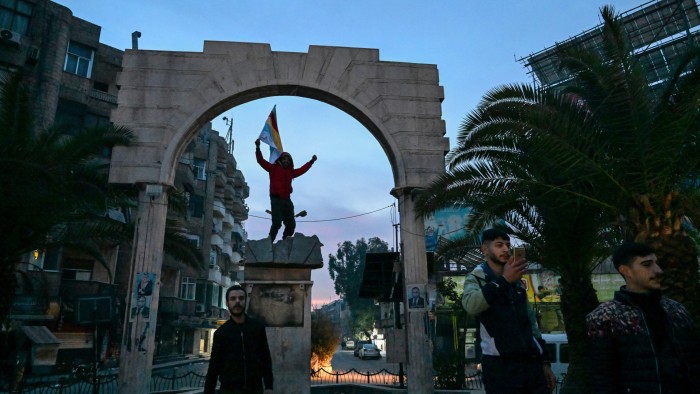Syrian rebels seized Damascus on Sunday as President Bashar al-Assad’s regime collapsed in the face of the insurgents’ stunning offensive across the country.
The rebels said in a statement that “the city of Damascus is free from the tyrant Bashar al-Assad” and that “Assad has fled” after various factions encircled the capital from the north and the south.
The whereabouts of Assad were unclear, as the rebel onslaught brought an ignominious end to a family dynasty that has ruled Syria for more than 50 years.
“Assad is gone,” US president-elect Donald Trump posted on his Truth Social network. “Russia, led by Vladimir Putin, was not interested in protecting him any longer.”
Videos sent to the Financial Times by a Damascus resident purportedly showed people inside the presidential palace, rummaging through rooms and smashing pictures of the Assad family.
A man dressed in civilian clothing appeared on Syrian state TV on Sunday morning declaring that the rebels had “liberated” Damascus and released detainees from “regime prisons”. He called on fighters to “protect the properties of the free Syrian state”.
The speaker was flanked by eight other men, also in civilian clothes. Several of the men had their arms around each others’ shoulders.
Residents of Damascus said there was celebratory shooting in the air, with clouds of smoke hanging across the capital.
“I can’t believe it. Everyone is in the street, everyone is shouting,” said Abdallah, a Damascus resident. “It’s something historical. No one has suffered as much as the Syrian people.”
He added that rebel militants were posted outside banks and other public institutions to guard them.
While the downfall of the Assad regime sparked celebrations across Syria, it will also usher in a period of huge uncertainty for a nation shattered and fragmented after 13 years of civil war, and for the wider region. The country shares borders with Israel, Jordan, Iraq and Lebanon. Rebel groups have clashed with each other in the past.
The rebel offensive has been led by Hayat Tahrir al-Sham, an Islamist movement that was confined to Syria’s north-west province of Idlib before beginning its offensive 12 days ago. The group, which was once an affiliate of al-Qaeda, rocked the country by seizing Aleppo, Syria’s second city, within 48 hours and then marching southwards towards the capital.
It has been working with Turkish-backed rebels who operate under the umbrella of the Syrian National Army, but Syria is home to myriad factions and the degree of co-ordination between them all is unclear.
As rebels entered the palace, Syrian Prime Minister Mohammad Ghazi al-Jalali said he was ready to work with any leadership chosen by the people and called for unity, saying “Syria is for all Syrians”. “We are ready to co-operate and all the properties of the people and the institutions of the Syrian state must be preserved,” he said. “They belong to all Syrians.”
Jalali said he last had contact with Assad on Saturday evening and has no idea where he is. Soon after he spoke, video emerged of armed rebels leading Jalali from his office to a car.
There was no official statement by the Syrian presidency, the military or state media about Assad or the situation in the country. Al-Ekhbaria, one state-run TV channel, had been broadcasting pre-recorded footage of Syrian architecture set to light guitar music.
Assad, a London-trained eye doctor, has ruled Syria since 2000, when he succeeded his late father Hafez al-Assad. The civil war broke out in 2011 after his forces brutally sought to put down a popular uprising.
He managed to cling to power with the backing of Iran, Iranian-backed militants and Russia, which provided vital air power. His regime had regained control over most of the country in recent years.
But he presided over a hollowed-out, bankrupt state and even many among his own Alawite community appeared to have given up on the regime after years of conflict and economic hardship.
When HTS mounted its offensive on November 27, regime forces seemed to melt away, while Russia, Iran and Hizbollah, the Lebanese militant movement, were all distracted by their own conflicts.
“Russia and Iran are in a weakened state right now, one because of Ukraine and a bad economy, the other because of Israel and its fighting success,” Trump posted, calling for “an immediate ceasefire and negotiations” to end the Ukraine war.
The Syrian rebels said they had gained full control of the strategic city of Homs, the last major city on the highway south to Damascus, in the early hours of Sunday.
Southern rebels, separate from HTS, took over Deraa, the birthplace of the Syrian uprising in 2011, as well as the cities of Suwaida and Quneitra, over the weekend, encircling Damascus from the south.
The rebel success is a humiliating blow to Iran, which reportedly pulled people out of Syria, and to Russia. Moscow gained access to air and naval bases on the Mediterranean after intervening in the war in 2015.
Russia’s foreign minister Sergei Lavrov had said on Saturday that Moscow would stand by its ally and was “trying to do everything not to allow terrorists to prevail, even if they say they are no longer terrorists”.
Meanwhile, Tehran’s support for Assad had given it a “land bridge” across Iraq to Syria and Lebanon, home to its most important proxy, Hizbollah.
HTS is designated a terrorist organisation by the US, the UN, Turkey and other powers, while Jolani, its leader, has a $10mn US bounty on his head.
In recent years, Jolani has sought to rebrand the group as a more moderate Islamist movement, building up an autocratic, centralised movement with a tight grip on Idlib, which is home to 3-4mn people.
The rebels said they had freed prisoners from the notorious Sednaya prison, which had become a symbol of the Assad regime’s brutal repression of its political opponents.
On Saturday, Turkish President Recep Tayyip Erdoğan, who has long backed some Syrian opposition forces, hailed “a new diplomatic and political reality in Syria”.
Read the full article here














